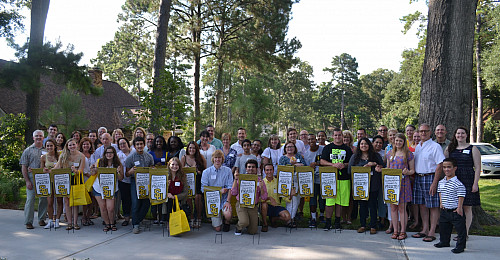
- howet@southwestern.edu
- 512.863.1376
- Fine Arts 243

Parent Leadership Gift Council members and fellow parent volunteers warmly welcome new students and their families to Southwestern at send-off parties across the state.
more information
Emilie Moeller ’18 shares how her time at Southwestern transformed her from a shy Unicorn Handler to a confident sorority president and tennis team captain.
more information
To give you a glimpse into one student’s recent Friday night, Keyshaan Castle ’20 , takes us behind the scenes of a blacklight dodgeball tournament, hosted by Zeta Tau Alpha and SIRA.
more information
Karim Clarke ’26 shares his eye-opening Houston Methodist Research Institute internship journey.
more information
Quincy Holland ’19 is the nineteenth recipient from SU to earn the Texas Association of School Personnel Administrators
more information
Alejandro Medina ’24 demonstrates outstanding potential in computing research by the Computing Research Association.
more information
Student’s study unveils the connections between education, gender, and belief in conspiracy theories.
more information
Karim Clarke ’26 shares his eye-opening Houston Methodist Research Institute internship journey.
more information
Parent Leadership Gift Council members and fellow parent volunteers warmly welcome new students and their families to Southwestern at send-off parties across the state.
more information
Emilie Moeller ’18 shares how her time at Southwestern transformed her from a shy Unicorn Handler to a confident sorority president and tennis team captain.
more information
To give you a glimpse into one student’s recent Friday night, Keyshaan Castle ’20 , takes us behind the scenes of a blacklight dodgeball tournament, hosted by Zeta Tau Alpha and SIRA.
more information
Alejandro Medina ’24 demonstrates outstanding potential in computing research by the Computing Research Association.
more information
Karim Clarke ’26 shares his eye-opening Houston Methodist Research Institute internship journey.
more information
Alejandro Medina ’24 demonstrates outstanding potential in computing research by the Computing Research Association.
more information
SU celebrates four campus community members with the 2024 Mundy Awards and recognizes those who have achieved milestone anniversaries with the University.
more information
SU Business Club collaborates with Houston Methodist Hospital in annual case study competition.
more information
A group of students attended a conference focused on empowering and developing Hispanic leadership.
more information
Students work with faculty and staff to create an interactive digital map of Southwestern’s campus.
more information
Parent Leadership Gift Council members and fellow parent volunteers warmly welcome new students and their families to Southwestern at send-off parties across the state.
more information
Students work with faculty and staff to create an interactive digital map of Southwestern’s campus.
more information
Professor of Art History Thomas Noble Howe co-published a peer-reviewed online monograph with Prof. Joseph C. Williams (Univ. of Maryland), Adan Ramos (UMd), and Gabriel Maslen (UMd and Tecnico di Milano), “The Role of the Field Architect in the Digital Age: Integrating Human and Electronic Recording at the Villa Arianna in Roman Stabiae”, The Journal for Field Archaeology, Received 17 Apr 2023, Accepted 04 Sep 2023, Published online: 11 Oct 2023. Howe is the overall director of the project and began to develop the technique of using conventional digital survey commands in the then-nascent digital laser EMD (Electronic Measuring Distance) surveying instruments to develop an efficient means of using surveying line commands to create a precise 3D “line wire cage drawing” to guide the completion of on-site hand drawings. He was the chief field architect and associate director of the American Academy in Rome Palatine Excavation project (1988-1994) and has been the director general of the Restoring Ancient Stabiae project since 1998.
—October 2023Two chapters published by Professor of Art and Architecture Thomas Noble Howe in Jan. 2020 for the 21st Edition of Sir Banister Fletcher’s A History of Architecture (see Jan. 2020, by Royal Institute of British Architects, Bloomsbury Press, Jan. 2020): “Hellenistic Architecture” (17,000 words) and “The Christian Roman Empire, A.D. 306-c. A.D. 500,” (11,000 words), pp. 284-331; 409-43 was awarded the prestigious Colvin Prize for 2020 by the Society of Architectural Historians of Great Britain. It was recently awarded the Special Prize in the 2023 Architectural Book of the Year Awards at the World Architecture Festival (WAF), which was open to all books published over the last three years. Bloomsbury tells us that the book’s online version is currently licensed by 253 institutions worldwide. Altogether, this amounts to an astonishingly high level of online readership for the new Banister Fletcher, which far surpasses the previous book-based editions. The 21st Edition seems easily to exceed the readership figures for any previous global architectural history survey. Altogether, this amounts to an astonishingly high level of online readership for the new Banister Fletcher, which far surpasses the book-based previous editions (for comparison’s sake, the print-only 20th Edition managed to sell 25,000 hard copies over the 25-year period following its 1996 publication).
—July 2023Professor of Art and Art History Thomas Howe was invited to attend the opening of a major new exhibition of Roman painting at the San Antonio Museum of Art, “Roman Landscapes: Visions of Nature and Myth from Rome and Pompeii,” on February 23. Howe was part of the technical advisory committee for the exhibit, and several frescoes from his archaeological site of the Roman villas of Stabiae were included in the exhibit. The exhibit will be open until May 21, 2023. Howe will be lecturing in San Antonio on recent discoveries from his site in April.
—February 2023On February 8-10, Professor of Art and Art History Thomas Howe was invited to do a department review of an undergraduate interdisciplinary architecture major at Birmingham Southern College in Birmingham, AL, of a program introduced five years ago largely based on the Architecture Minor which Howe introduced at Southwestern in 1985.
—February 2023Professor of Art History Thomas Howe recently reviewed two books for the American Journal of Archaeology: Oplontis: Villa A (“of Poppaea”) at Torre Annunziata, Italy, Volume 2: The Decorations: Painting, Stucco, Pavements, Sculptures, edited by John R. Clarke and Nayla K. Muntasser, and Archaeological Exploration of Sardis Report 7: The Temple of Artemis at Sardis by Fikret K. Yegül (review to be published in January 2023). The two books represent two radically different approaches to current high-quality archaeological publication. The first is completely digital and lavishly illustrated beyond the normal means of hard-copy publication, while the second is a very traditional hard copy with plates, also lavishly illustrated with line drawings by the author. Clarke and Howe currently lead the excavations of the two largest villas in the Bay of Naples (Stabiae and Oplontis), and Clarke and Muntasser have both lectured at Southwestern. Howe began his archaeological career in 1980 at Sardis and made a few short contributions that Yegül generously credits with having clarified the controversial issue of the chronology of the Artemis temple.
—August 2022